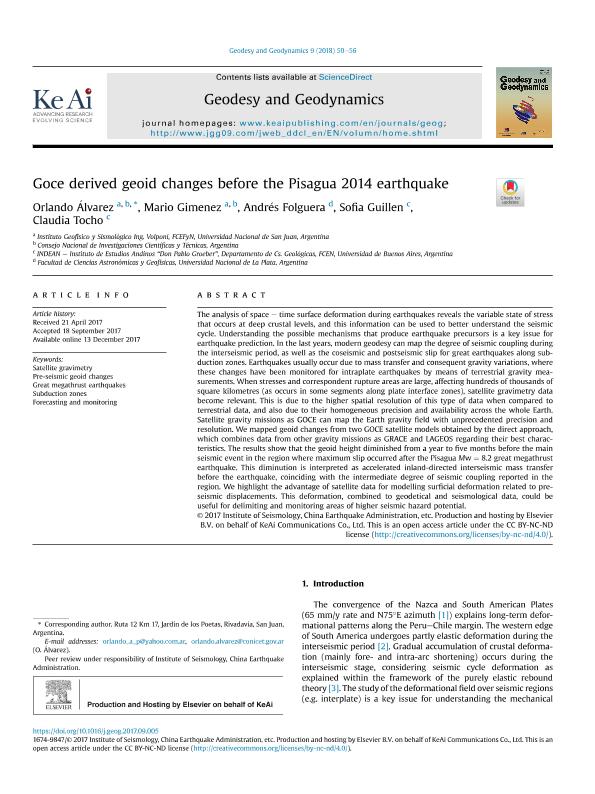Artículo
Goce derived geoid changes before the Pisagua 2014 earthquake
Alvarez Pontoriero, Orlando ; Gimenez, Mario Ernesto
; Gimenez, Mario Ernesto ; Folguera Telichevsky, Andres
; Folguera Telichevsky, Andres ; Guillen, Sofia; Tocho, Claudia
; Guillen, Sofia; Tocho, Claudia
 ; Gimenez, Mario Ernesto
; Gimenez, Mario Ernesto ; Folguera Telichevsky, Andres
; Folguera Telichevsky, Andres ; Guillen, Sofia; Tocho, Claudia
; Guillen, Sofia; Tocho, Claudia
Fecha de publicación:
01/2018
Editorial:
Elsevier
Revista:
Geodesy and Geodynamics
ISSN:
1674-9847
Idioma:
Inglés
Tipo de recurso:
Artículo publicado
Clasificación temática:
Resumen
The analysis of space – time surface deformation during earthquakes reveals the variable state of stress that occurs at deep crustal levels, and this information can be used to better understand the seismic cycle. Understanding the possible mechanisms that produce earthquake precursors is a key issue for earthquake prediction. In the last years, modern geodesy can map the degree of seismic coupling during the interseismic period, as well as the coseismic and postseismic slip for great earthquakes along subduction zones. Earthquakes usually occur due to mass transfer and consequent gravity variations, where these changes have been monitored for intraplate earthquakes by means of terrestrial gravity measurements. When stresses and correspondent rupture areas are large, affecting hundreds of thousands of square kilometres (as occurs in some segments along plate interface zones), satellite gravimetry data become relevant. This is due to the higher spatial resolution of this type of data when compared to terrestrial data, and also due to their homogeneous precision and availability across the whole Earth. Satellite gravity missions as GOCE can map the Earth gravity field with unprecedented precision and resolution. We mapped geoid changes from two GOCE satellite models obtained by the direct approach, which combines data from other gravity missions as GRACE and LAGEOS regarding their best characteristics. The results show that the geoid height diminished from a year to five months before the main seismic event in the region where maximum slip occurred after the Pisagua Mw = 8.2 great megathrust earthquake. This diminution is interpreted as accelerated inland-directed interseismic mass transfer before the earthquake, coinciding with the intermediate degree of seismic coupling reported in the region. We highlight the advantage of satellite data for modelling surficial deformation related to pre-seismic displacements. This deformation, combined to geodetical and seismological data, could be useful for delimiting and monitoring areas of higher seismic hazard potential.
Archivos asociados
Licencia
Identificadores
Colecciones
Articulos(CCT - SAN JUAN)
Articulos de CENTRO CIENTIFICO TECNOLOGICO CONICET - SAN JUAN
Articulos de CENTRO CIENTIFICO TECNOLOGICO CONICET - SAN JUAN
Citación
Alvarez Pontoriero, Orlando; Gimenez, Mario Ernesto; Folguera Telichevsky, Andres; Guillen, Sofia; Tocho, Claudia; Goce derived geoid changes before the Pisagua 2014 earthquake
; Elsevier; Geodesy and Geodynamics; 9; 1; 1-2018; 50-56
Compartir
Altmétricas



